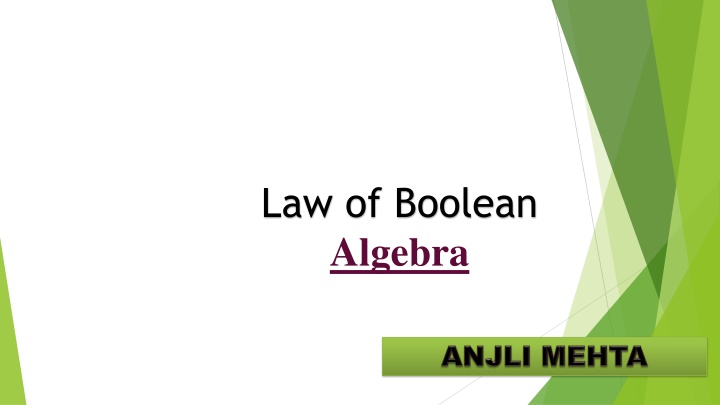
Laws of Boolean Algebra for Logical Circuit Design
Explore the fundamental laws of Boolean Algebra, including identity, annulment, idempotent, complement, double negation, and commutative laws. Learn how these rules are used in digital circuit design to optimize logic operations efficiently.
Download Presentation

Please find below an Image/Link to download the presentation.
The content on the website is provided AS IS for your information and personal use only. It may not be sold, licensed, or shared on other websites without obtaining consent from the author. If you encounter any issues during the download, it is possible that the publisher has removed the file from their server.
You are allowed to download the files provided on this website for personal or commercial use, subject to the condition that they are used lawfully. All files are the property of their respective owners.
The content on the website is provided AS IS for your information and personal use only. It may not be sold, licensed, or shared on other websites without obtaining consent from the author.
E N D
Presentation Transcript
Law of Boolean Algebra
Boolean The logical symbol 0 and 1 are used for representing the digital input or output. The symbols "1" and "0" can also be used for a permanently open and closed digital circuit. The digital circuit can be made up of several logic gates. To perform the logical operation with minimum logic gates, a set of rules were invented, known as the Laws of Boolean Algebra. These rules are used to reduce the number of logic gates for performing logic operations. The Boolean algebra is mainly used for simplifying and analyzing the complex Boolean expression. It is also known as algebra because we only use binary numbers in this. George Boole developed the binary algebra in 1854. Binary
Rules in Boolean algebra 1.Only two values(1 for high and 0 for low) are possible for the variable used in Boolean algebra. 2.The overbar(-) is used for representing the complement variable. So, the complement of variable C is represented as . 3.The plus(+) operator is used to represent the OR ing of the variables. 4.The dot(.) operator is used to represent the AND ing of the variables.
Annulment Law When the variable is AND with 0, it will give the result 0, and when the variable is OR with 1, it will give the result 1, i.e., B.0 = 0 B+1 = 1
Identity Law When the variable is AND with 1 and OR with 0, the variable remains the same, i.e., B.1 = B B+0 = B
Idempotent Law When the variable is AND and OR with itself, the variable remains same or unchanged, i.e., B.B = B B+B = B
Complement Law When the variable is AND and OR with its complement, it will give the result 0 and 1 respectively. B.B' = 0 B+B' = 1
Double Negation Law This law states that, when the variable comes with two negations, the symbol gets removed and the original variable is obtained. ((A)')' = A
Commutative Law This law states that no matter in which order we use the variables. It means that the order of variables doesn't matter in this law. A.B = B.A A+B = B+A
Associative Law This law states that the operation can be performed in any order when the variables priority is of same as '*' and '/ . (A.B).C = A.(B.C) (A+B)+C = A+(B+C)
Distributive Law This law allows us to open up of brackets. Simply, we can open the brackets in the Boolean expressions. A+(B.C) = (A+B).(A+C A.(B+C) = (A.B)+(A.C)
Absorption Law This law allows us for absorbing the similar variables. B+(B.A) = B B.(B+A) = B
De Morgan Law The operation of an OR and AND logic circuit will remain same if we invert all the inputs, change operators from AND to OR and OR to AND, and invert the output. (A.B)' = A'+B (A+B)' = A'.B'
